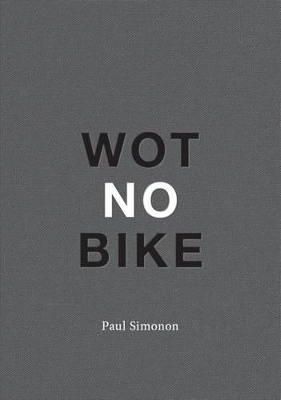`Wot No Bike’ is a limited print run publication of the work of Paul Simonon (b.1955, London). Simonon is a London-based artist and musician who came to prominence with the punk band The Clash in the late 1970s, with whom he played bass guitar. Simonon had started studying at art school, but soon became disillusioned by the style of teaching and left. It was at this time that he bumped into Mick Jones who asked him if he wanted to form a band. As an aspiring painter who had never previously played bass, he first took a lead role in the band’s visual identity, rapidly learning to play the instrument as he went along. Simonon has always been passionate about art, and since the band split in the mid 1980s, painting has become as important as his music career. Simonon’s passion for painting began as a boy – his father was an avid amateur painter and Paul spent a lot of time in his studio, often sleeping there. It was here, surrounded by books and pictures pinned to the walls that he first encountered the works of nineteenth- and twentieth-century masters, from Impressionism to Cubism and beyond. Introduced to an artist friend of his father, Paul began assisting him on projects at an inner city London school, where he learnt the basics of using paint, supplemented by teaching himself at home. Using his days off when on tour with the band to visit museums and galleries, his enthusiasm for, and knowledge of, the history of art has continued to grow ever since. In recent years, his fascination with French fin-de-siècle painting has literally taken him on the trail of Paul Gauguin, to the islands of French Polynesia. In addition to French modernist painting of the late nineteenth century, Simonon’s painting practice has been heavily influenced by twentieth-century realism, particularly the American Ashcan School, which documented New York’s working class life at the turn of the century, and the British `Kitchen Sink’ school of painters of the 1950s. The latter formed a part of the wider social realism movement – both in the arts and popular culture – that focused attention on the living conditions of the working classes in post-War Britain, characterised by the ordinary, humble and banal at its best, and by poverty, misery, angst, violence and abuse at its worst. The difficult financial and domestic situations of many of the urban poor in Britain at this time served as a backdrop to the emergence of Ted, Biker and Rocker subcultures that first appeared in these years – subcultures that actually spanned economic and class divides. Growing up in London in the 1960s, Simonon’s first experiences of this came in the form of the clash between the Mods and Rockers subcultures, a tension which fuelled into the wider dynamics of the `angry young man’ attitude and social unrest that came to define youth culture of this period, and which were the genesis of Punk culture in the 1970s. While Simonon is cautious about drawing parallels between his music and his painting, it is clear that British subculture of the 1950s, 1960s and 1970s has been, and remains, essential to both aspects of his life and work. Simonon has been a Biker since he was old enough to ride one – his first was a white and gold Triumph 3TA, and it was this, along with subsequent bikes, that established him in the 1970s within the remarkable community of Bikers discussed in David Lancaster’s introduction to the publication. The bikes, jackets, boots, helmets, gloves and other biking paraphernalia that feature in Simonon’s paintings are his own possessions, things that he uses pretty much every day. As such, the paintings are as much in the tradition of self-portraits as still lifes: “It’s like writing a diary, in a way, but in paint”, says Simonon in the course of an engaging conversation with art historian Tim Marlow also featured in the publication. With an independent-minded, outsider spirit, Simonon’s paintings in `Wot No Bike’ bring British subcultures of the 1950s to 1970s into dialogue with modernist and realist painting traditions, particularly the social realism that came to the fore as these subcultures were emerging. Bound up in the middle of this is Simonon himself – his personal history, family, childhood, adolescence, adult life, social life, private life, music and, in fact, his inner life. Simonon has often kept his painting practice relatively low key, sometimes exhibiting at galleries and selling works privately. Encouraged by Anomie Publishing to collaborate on a publication about his recent body of painting, Simonon has been personally involved in the book’s development, resulting in a cloth-bound hardback publication in an edition of 1000 copies. Edited by Bruce Cameron and Serena Rees, and designed by Martin Bell / Fruitmachine, the publication features twenty-two new and recent paintings under the banner of `Wot No Bike’.
- ISBN10 1910221023
- ISBN13 9781910221020
- Publish Date 23 January 2015
- Publish Status Active
- Out of Print 26 January 2021
- Publish Country GB
- Imprint Anomie Publishing
- Format Hardcover
- Pages 64
- Language English
